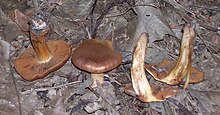| Lethal webcaps | |
|---|---|

| |
| Deadly webcap, Cortinarius rubellus | |

| |
| Fool's webcap, Cortinarius orellanus | |
| Scientific classification | |
| Kingdom: | |
| Division: | |
| Class: | |
| Order: | |
| Family: | |
| Genus: | |
| Species: | C. rubellus
C. orellanus |
| Binomial name | |
| Cortinarius rubellus | |
| Cortinarius orellanus | |
| Cortinarius rubellus | |
|---|---|
| Gills on hymenium | |
| Cap is umbonate | |
| Hymenium is adnexed | |
| Stipe has a cortina | |
| Spore print is brown | |
| Ecology is mycorrhizal | |
| Edibility is deadly | |
The Orellani are a group of seven related species in the genus Cortinarius that have been classified as a section of the subgenus Leprocybe or a subgenus in their own right.[1] They are among world's most poisonous mushrooms as they contain the highly toxic compound orellanine. The best-known species are the deadly webcap (Cortinarius rubellus, formerly also known as C. speciosissimus or C. orellanoides) and the fool's webcap, C. orellanus.
The mushrooms' characteristics are quite common, making them difficult to identify, which often leads to fatal poisonings. Young examples of the species often have a veil between the cap of the mushroom and the stem. This veil looks like a cobweb, hence the name. The veil however partially or completely disappears in older specimens. Some other characteristics for each of the mushrooms are given below.
- ^ Gasparini B (2004). "Cortinarius subgenus Orellani in Australia and in the world" (PDF). Australasian Mycologist. 23 (2): 62–76.